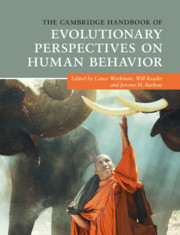Book contents
- The Cambridge Handbook of Evolutionary Perspectives on Human Behavior
- The Cambridge Handbook of Evolutionary Perspectives on Human Behavior
- Copyright page
- Dedication
- Contents
- Figures
- Tables
- Contributors
- Preface
- Acknowledgments
- Part I The Comparative Approach
- Part II Sociocultural Anthropology and Evolution
- Part III Evolution and Neuroscience
- Part IV Group Living
- 10 The Problem of Altruism and Future Directions
- 11 Can Evolutionary Processes Explain the Origins of Morality?
- 12 The Evolution and Function of Third-Party Moral Judgment
- 13 Evolution of the Human Family
- 14 The Parasite-Stress Theory of Cultural Values and Sociality
- 15 The Evolution of Pride and Shame
- 16 Thinking Outside the Head
- Part V Evolution and Cognition
- Part VI Evolution and Development
- Part VII Sexual Selection and Human Sex Differences
- Part VIII Abnormal Behavior and Evolutionary Psychopathology
- Part IX Applying Evolutionary Principles
- Part X Evolution and the Media
- Index
- References
14 - The Parasite-Stress Theory of Cultural Values and Sociality
from Part IV - Group Living
Published online by Cambridge University Press: 02 March 2020
- The Cambridge Handbook of Evolutionary Perspectives on Human Behavior
- The Cambridge Handbook of Evolutionary Perspectives on Human Behavior
- Copyright page
- Dedication
- Contents
- Figures
- Tables
- Contributors
- Preface
- Acknowledgments
- Part I The Comparative Approach
- Part II Sociocultural Anthropology and Evolution
- Part III Evolution and Neuroscience
- Part IV Group Living
- 10 The Problem of Altruism and Future Directions
- 11 Can Evolutionary Processes Explain the Origins of Morality?
- 12 The Evolution and Function of Third-Party Moral Judgment
- 13 Evolution of the Human Family
- 14 The Parasite-Stress Theory of Cultural Values and Sociality
- 15 The Evolution of Pride and Shame
- 16 Thinking Outside the Head
- Part V Evolution and Cognition
- Part VI Evolution and Development
- Part VII Sexual Selection and Human Sex Differences
- Part VIII Abnormal Behavior and Evolutionary Psychopathology
- Part IX Applying Evolutionary Principles
- Part X Evolution and the Media
- Index
- References
Summary
The parasite-stress theory of values or sociality is a recent, encompassing perspective in human social psychology and behavior. As an ecological and evolutionary theory of peoples’ cultural values/core preferences, it applies widely across many domains of human social life and human affairs. It is a general theory of human culture and sociality. Fundamental to the theory is the behavioral immune system. The human behavioral immune system includes: psychological traits and manifest behaviors for avoiding contact with infectious diseases; behaviors of in-group social preference, altruism, alliance, and conformity that manage the negative effects of infectious diseases; mate choice to increase personal and offspring defense against parasites; culinary behavior; and components of personality. The contagion-avoidance aspect of behavioral immunity is much more than out-group avoidance and dislike (xenophobia). It also includes the preference for the natal or local region (philopatry) and hence avoidance of foreignness in people and places where novel parasites may occur. The parasite-stress theory has produced a cornucopia of newly discovered patterns and informed and reinterpreted previously described patterns in the behavior of individuals and at the level of cultures/societies and regions. In novel ways, it informs and synthesizes knowledge of major features of the social lives and societal-level affairs of people, ranging from prejudice and egalitarianism to personality, economic patterns, core values, interpersonal and intergroup violence, governmental systems, gender relations, family structure, and the genesis and maintenance of cultural diversity across the world.
Keywords
- Type
- Chapter
- Information
- Publisher: Cambridge University PressPrint publication year: 2020
References
- 1
- Cited by



